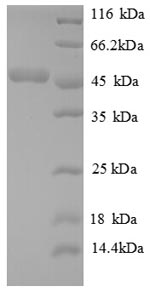Amino acids 24-213 constitute the expression domain of recombinant Human ATP5O. This ATP5O protein is expected to have a theoretical molecular weight of 47.9 kDa. This protein is generated in a e.coli-based system. The N-terminal GST tag was fused into the coding gene segment of ATP5O, making it easier to detect and purify the ATP5O recombinant protein in the later stages of expression and purification.
The research on ATP synthase subunit O, mitochondrial (ATP5PO) covers the fields of cell biology, mitochondrial biology, and diseases related to metabolism. ATP5PO is a subunit within the mitochondria, belonging to the ATP synthase complex. One of the prominent areas of study is its crucial role in cellular energy production. Researchers focus on the role of ATP5PO in the mitochondrial respiratory chain, particularly its involvement in the formation of the ATP synthase complex and the mechanisms of catalytic reactions. Additionally, ATP5PO is associated with the pathogenesis of many diseases, especially those related to mitochondrial dysfunction and disruptions in cellular energy metabolism. Research on these diseases contributes to uncovering their causes and providing potential targets for future treatments.




